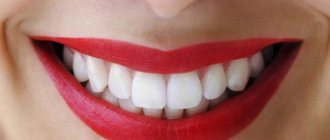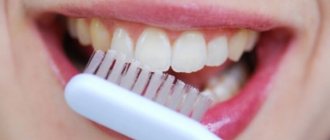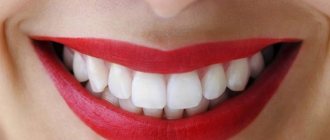Types of Tartar
Tartar has its own classification - according to the field of education. Based on this feature, mineralized deposits are divided into two types:
- Subgingival calculus. Deposits accumulate under the edge of the gums, in the area of the gum pockets. A characteristic feature of subgingival tartar is its increased hardness. Mineralized subgingival deposits can cause an active inflammatory process in the periodontium (soft tissues of the oral cavity) and lead to gingivitis or periodontitis. It is impossible to remove subgingival stone at home: only a dentist can remove deposits in this area;
- Supragingival tartar forms above the gum level and is therefore clearly visible on the teeth. It can become stained from contact with food, and in smokers it has a distinct yellow or brown color. Supragingival tartar harms the healthy state of enamel, increases the risk of caries and, of course, spoils the appearance of teeth. It needs to be removed urgently, because the longer the stone is on the teeth, the denser and harder it becomes.
Symptoms such as the appearance of bad breath, discoloration of the gums, heavy plaque on the teeth after eating, and roughness of the teeth may tell you that tartar has formed on your teeth. If you observe such signs in yourself, be sure to contact the dentist for tartar removal and professional oral hygiene!
Methods for removing tartar used in dentistry
Previously, only mechanical cleaning was used to remove tartar in dentistry, which involved the use of special hand tools: scalers, curettes, excavators, smoothers, chisels, rasps. The procedure was labor-intensive, long and painful for the patient, and also very traumatic.
When manually removing tartar, a fairly large layer of healthy tissue was removed from the teeth and this led to unpleasant sensitivity of the teeth and thinning of the tooth enamel. Nowadays, mechanical removal of tartar is used extremely rarely, only in cases where the patient has contraindications to other methods of cleaning teeth from deposits.
Another outdated and rarely used method of removing plaque is to clean teeth from plaque using special chemical solutions.
The teeth were treated with preparations based on alkalis or acids that dissolve mineralized deposits. However, the chemical method of removing tartar is aggressive, it carries a high risk of burns to the soft tissue of the oral cavity, it negatively affects the condition of tooth enamel, so dentists have long abandoned its use. Nowadays, two modern and highly effective methods are used to remove tartar - ultrasonic cleaning and laser cleaning. We will tell you about these technologies in detail below.
Disadvantages of ultrasonic cleaning
There are no downsides to ultrasonic cleaning, but you need to know that some pain may still be present during it. Unpleasant sensations are observed when removing plaque from the subgingival space, as well as when treating tooth enamel in the root zone. But there is no need to be afraid or put off ultrasonic cleaning: all possible pain is easily eliminated with local anesthesia.
It is worth considering that ultrasonic cleaning has contraindications. Patients with severe cardiovascular pathologies, people using pacemakers, suffering from asthma and serious respiratory diseases will have to refuse to use ultrasound in teeth cleaning. Ultrasonic cleaning is not carried out in children and adolescents, since the enamel of children's teeth is too thin; young patients may be offered an alternative to ultrasonic cleaning - the Air Flow technique.
Ultrasound removal of tartar
Ultrasonic tartar removal is a technology that allows you to quickly and painlessly remove mineralized plaque without damaging tooth enamel. The procedure will use a special ultrasonic device with a tip - a scaler. The generator in the device creates ultrasonic waves, which are transmitted to the scaler. The frequency of the waves can be adjusted, which gives the dentist the opportunity to choose the most effective and safe mode of operation.
When removing tartar with ultrasound, different types of tips can be used. By changing the tips, the dentist will clean the outer part of the teeth from mineralized deposits and remove plaque in the subgingival area. Effective and rapid removal of tartar is due to a double action:
- An ultrasonic wave is applied to the tip with a certain frequency, creating vibrations that destroy tartar mechanically;
- Since ultrasonic cleaning can be carried out using liquid, the simultaneous supply of water and ultrasonic waves leads to the effect of cavitation or, in simple words, the formation of a large number of microbubbles that loosen tartar and improve the process of its separation from tooth enamel.
The scalers of modern ultrasonic devices are equipped with illumination, which improves the quality of tartar removal.
Main stages of enamel processing
Before examining in detail how to clean and remove tartar with ultrasound, it is necessary to take into account some features of the procedure. So, for example, if a patient experiences inflammatory processes in the gum tissue, or there are signs of periodontitis, it is necessary for the periodontist to do the cleaning. The specialist must know how to properly remove the stone, including removing it from under the gums. If necessary, the doctor will prescribe anti-inflammatory therapy. The process of processing enamel also involves its subsequent mandatory polishing, and ideally also saturation with fluoride. Let's look at each stage in more detail.
Cleaning enamel with a scaler
A special device is used - an ultrasonic scaler (scaler or scaler). It can be a self-installation or a built-in part of dental equipment. The device is equipped with a special tip with a metal attachment, which, in turn, makes oscillatory movements (25-50 kHz) in the ultrasonic range1. The nozzle also provides a powerful stream of water to flush away any remaining deposits.
Surface polishing
The next and no less important stage after treating the enamel with an ultrasonic scaler. This effect on the surface of the teeth allows you to remove the smallest particles of plaque and stone. Currently, two main polishing methods are used in dentistry:
- with the help of brushes and pastes - with their help, all surfaces of the elements of the dentition are treated, and for the interdental spaces they resort to the help of special thin brushes - strips,
- Air Flow is a hardware technique that involves the use of a device of the same name that supplies a high-pressure stream of air and water with the addition of abrasive particles. It is worth noting that “Air Flow” is widely used as an independent method for gently cleaning enamel from soft plaque, and is also very often carried out after ultrasonic cleaning.
The photo shows teeth brushing with the Air Flow system.
The next important step is fluoride treatment. It is not always carried out, but it is desirable that the procedure is still included in comprehensive ultrasonic cleaning.
Treatment of enamel with a fluorine-containing composition - fluoridation
After treatment with ultrasound and Air Flow, teeth become especially susceptible to the effects of vitamins and minerals, which means that such a final procedure will have maximum effect. In addition, it will help reduce hyperesthesia in the cervical area - this is where the teeth become especially susceptible after removing hardened deposits. Fluoridation involves applying special gels and varnishes with a high concentration of fluorine and calcium to the enamel.
Fluoridation of teeth will strengthen enamel
Benefits of ultrasonic tartar removal
Ultrasonic tartar removal technology has the following advantages:
- It is highly effective; using ultrasound, it is possible to remove tartar from both the external surfaces of the teeth and the subgingival space;
- When removing tartar, ultrasound does not injure or damage tooth enamel;
- Ultrasound destroys pathogenic microflora in the oral cavity, and therefore removal of stone and plaque by ultrasonic cleaning is an excellent prevention of various dental diseases;
- The procedure for removing tartar using ultrasound is quick and painless for the patient.
The advantages of ultrasonic tartar removal include the affordable price of the service. Ultrasonic cleaning is universal and can be carried out as an independent hygienic procedure or in combination with Air Flow cleaning. It is imperative to remove tartar with ultrasound before dental treatment, prosthetics, implantation, or wearing braces.
Pros and cons of the procedure, possible contraindications
Despite many positive reviews about the procedure, not all people can undergo ultrasonic teeth cleaning. It is contraindicated in the following cases:
- if the patient has serious diseases of the cardiovascular system, asthma or chronic bronchitis;
- in the presence of cancer;
- for tuberculosis, AIDS or hepatitis;
- for epilepsy and diabetes;
- in case of acute respiratory diseases or inability to breathe through the nose;
- for those patients who have implants or orthopedic devices;
- for those whose enamel is too sensitive;
- children before the change of milk teeth.
- It is not recommended to carry out ultrasonic cleaning in the first half of pregnancy.
But despite this, this procedure has many advantages over mechanical and chemical teeth cleaning:
- it is more effective and removes plaque of any hardness even from hard-to-reach places;
- eliminates darkening of enamel due to smoking, food dyes or drinking coffee;
- eliminates allergic reactions and negative effects of chemicals on the body;
- does not damage the enamel and does not increase its sensitivity;
- ultrasound also removes bacteria, maintaining normal microflora in the oral cavity;
- slightly whitens and polishes teeth, restoring their natural color and shine;
- Serves as a prevention of caries and periodontitis.
But not everything is so rosy. There are also negative reviews from patients. They note that the procedure caused them pain. Indeed, this is possible if subgingival deposits are removed. But to prevent unpleasant sensations in this case, you just need to carry out cleaning under local anesthesia.
Laser tartar removal
Laser tartar removal has been used in dentistry relatively recently. This technology involves removing mineralized deposits with a directed laser beam. The procedure is quick, painless and has the following advantages:
- High security. The laser beam destroys only plaque and does not damage the enamel and soft tissues of the oral cavity;
- Laser radiation destroys pathogens and stops inflammatory processes;
- Laser tartar removal takes place without discomfort or pain.
The disadvantages of laser tartar removal include a fairly large list of contraindications and the high cost of the procedure.
Air Flow for removing tartar
Air Flow is a technology used for professional teeth cleaning. It copes well with pigmented soft plaque, helps lighten tooth enamel to its natural shade, refreshes and disinfects the oral cavity. But with so many advantages, Air Flow is ineffective in the fight against tartar.
If a large amount of hard dental deposits have accumulated in the patient’s oral cavity, to remove them, properly clean with ultrasound or laser and only then use Air Flow.
Chemical method
The chemical method of removing stones is an auxiliary method that is used in combination with other methods. Its essence is that if the stones are very hard, they are first softened using special acidic chemicals. Applied to the surface of the stone, they effectively and quickly dissolve part of the stone within a minute. After which the stone can be easily removed using an ultrasonic tip.
Benefits of chemical stone removal:
- Risk reduction - the chemical method softens the stones and makes them easier to remove. This reduces the risk of injury with the ultrasound method.
- Whitening effect - after exposure to acids on tooth enamel, the tooth becomes 2-3 shades lighter
- Time saving – the process takes from 30 to 60 seconds.
Flaws:
- This method has one significant drawback. When in contact with tooth enamel, the acids used in this technique have a negative effect on the protective mechanisms of the teeth, as a result of which the tooth can easily deteriorate.
Is it possible to remove tartar at home?
On the Internet you can find countless recipes that claim to help remove tartar. Most of these recipes involve the use of caustic substances that must be applied to the surface of the teeth and, under the influence of these substances, the tartar should dissolve.
But we do not advise you to conduct such experiments on your health. Using caustic solutions will not help you remove tartar, but it will weaken and destroy tooth enamel and can lead to burns of the soft tissues of the mouth and other unpleasant consequences. In addition, no folk remedies will relieve you of subgingival tartar.
You need to remember that tartar removal should be carried out in a dental clinic, by a competent hygienist who uses safe materials and modern tools in his work! There is no need to be afraid of this procedure - it is painless, and in addition, before removing tartar, you can always apply local anesthesia, which completely removes all possible unpleasant sensations.
Estimated cost of the service
The cost of the procedure at different medical centers may vary. How much it will cost to remove deposits with ultrasound depends on various factors, including whether further processing is carried out with an AirFlow device, what model of scaler is used, as well as on the pricing policy of the institution as a whole.
| Name of institution | Cost of the procedure, rub. |
| "Star-Dent" | 4 000 |
| Lanri Clinic | 3 000 |
| "Denta-El" | 4 900 |
| Smile-at-Once | 3 500 |
| "ONMED" | 5 100 |
The table shows approximate prices for the service in question - please check the exact price when contacting us. You need to understand that this is one of the few ways to remove hard deposits, and therefore protect yourself from caries and many other dental problems.
Ultrasonic cleaning has many undeniable advantages, including absolute safety and highest efficiency. Regularly undergoing such a procedure at least twice a year will be the best protection against inflammation and carious processes. In addition, systematic visits to the dentist’s office are required in any case, because for prevention such visits should be made at least twice a year.
Prevention of tartar formation
Is it possible to prevent tartar from forming? This question is often asked to dentists by patients after dental plaque removal procedures. Alas, there are no technologies in dentistry that would help get rid of tartar once and for all, but prevention can be carried out to promote the formation of deposits in smaller quantities and slow down the rate of their formation.
Effective prevention of tartar formation will include the following measures:
1. Regular brushing of teeth with the correct movements and the right toothbrush and toothpaste. If you don’t know which brush and paste are right for you, the dental hygienists of our clinic in Moscow, “Aesthetica”, will help you find the answer to this question!
2. When brushing your teeth, be sure to use dental floss or special brushes to help remove plaque and food debris from the spaces between your teeth.
3. Buy irrigators that help remove plaque from the subgingival space.
4. Stop smoking, drinking alcohol frequently, reduce the amount of sweet foods in your diet, and eat solid foods.
To remove tartar in a timely manner, visit the dentist once every six months and carry out professional oral hygiene procedures.
FAQ
This procedure is still new, people don't know much about it, so they have a lot of questions. Even those who have tried to have their teeth professionally cleaned once are afraid that they have caused harm to the enamel. What are patients most often interested in?
- Many people do not have professional cleanings because they believe that they are harmful to their teeth. But ultrasound does not have any mechanical effect on the enamel and does not damage it. Therefore, such cleaning is the simplest and safest.
- Patients are wondering whether the procedure will be too expensive? The price of ultrasonic cleaning depends on the quantity and quality of plaque, on how many teeth are affected by caries. Typically, this service is provided only by private clinics, but even in them it is not very expensive. The cost of professional cleaning of one tooth ranges from 100 to 150 rubles. For the complete procedure, the patient will pay from 1,500 to 3,000 rubles. But for this money you can then enjoy a snow-white smile for a long time.
- Some people are interested in the duration of the procedure. Complete ultrasonic cleaning takes about an hour. Additionally, you can do teeth whitening and polishing with an Air Flow device or polishing with special brushes. Special pastes or varnishes are applied to the teeth to reduce the sensitivity of the enamel and protect it from plaque formation.
- Many people are afraid of pain during the procedure, especially if they have sensitive enamel. In fact, most patients do not feel the effects of ultrasound at all. And only in some cases, when treating subgingival deposits or removing particularly large tartar, unpleasant sensations are possible.
- Is it possible to do ultrasonic teeth cleaning during pregnancy? This question is asked by many women. In fact, ultrasound does not harm the baby or the mother’s body. But due to a woman’s decreased immunity, bleeding gums or other complications may occur after the procedure. Therefore, it is better to resolve this issue with your doctor individually. It is not recommended to carry out the procedure in the first trimester, shortly before childbirth and in cases where the woman has never had ultrasonic cleaning before.
- Many patients who liked the procedure and how beautiful their teeth became after it are interested in how often ultrasonic cleaning can be done? Depending on the rate of plaque and tartar formation, dentists recommend doing this once every 1-2 years. But sometimes cleaning is required every six months.
In many cases, the effectiveness of the procedure depends on the professionalism of the doctor. Therefore, it is very important to choose the right clinic for oral care. And you need to pay attention not to prices, but to the qualifications of the staff. Many patients have learned from their own experience that it is cheaper to pay for preventive procedures than to later treat caries and periodontitis. And if ultrasonic cleaning is performed correctly, plaque will not form for a long time, and the patient will enjoy a snow-white smile and healthy teeth.
Comprehensive teeth cleaning: service from our dentistry in Moscow “Aesthetica”
To ensure high-quality removal of tartar, we offer our patients a comprehensive teeth cleaning service, which includes:
- Ultrasonic cleaning;
- Air Flow cleaning;
- Grinding and polishing of enamel;
- Fluoridation.
An integrated approach to teeth cleaning guarantees a high quality procedure and is an excellent prevention of caries and gum inflammation. After the cleaning procedure, our hygienists will definitely give you recommendations on proper oral hygiene to help keep your teeth beautiful and healthy.
In our clinic, modern equipment is used to carry out comprehensive teeth cleaning, and all conditions have been created for comfortable treatment and procedures. We are proud that we can offer you the best dental technologies, high-quality materials from world-famous manufacturers and, of course, our professionalism, knowledge and experience.
Dental clinic “Aesthetica” - with us your teeth will be healthy and your smile will be dazzling! Come to us: we have opened two branches for you in Moscow - in Barvikha and in Podsosensky Lane!
Restrictions to the procedure
It is worth noting that the technique under consideration has certain contraindications. Here are the main restrictions on the use of ultrasound:
- pathologies of blood vessels and heart,
- asthma, tuberculosis and other diseases related to the functioning of the lungs and respiratory system,
- infections, including HIV, hepatitis,
- the presence of implants and prosthetic devices in the mouth,
- children's age (up to 16-18 years),
- increased sensitivity of the enamel layer,
- diabetes,
- oncology,
- epilepsy and other disorders of the nervous system,
- reduced immunity, which manifests itself in frequent colds and other diseases.
During pregnancy, ultrasonic cleaning is allowed, but in the first trimester it is better to wait. During this period, the expectant mother’s body is overly sensitive and susceptible to any external influences.











